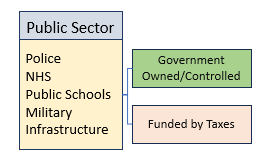AS Business Studies 9609
Business Studies – 1.2 Business Structure
- Classification of business – Sectors of the business activity
- Differences between Private and Public Sector
- Enterprise and Business Growth (Internal and External Growth)
Classification of business
Making a product and supplying it to customers involves businesses in all three sectors of the industry. For example, producing a cake.
- A farmer growing wheat (primary)
- A miller turning wheat into flour (secondary)
- The bakery makes flour into a cake (secondary)
- A shop that sells the cake to customers (tertiary)
- Transport from the farmer, miller and bakery (tertiary)
Sectors of industry
Businesses can be classified into four different sectors of industry which are primary, secondary, tertiary and quaternary. These are also known as stages of economic activity.
The importance of business classification
Over time, each sector within a country’s economy is likely to change.
Stages of production or economic sectors
The primary sector is the first stage of production. All businesses which are related to the extraction of raw materials from nature such as mining, fishing and farming Sector businesses. Raw materials that are extracted are sent to the secondary sector.
Businesses in the secondary sector convert raw materials into finished or semi-finished goods. All manufacturing and processing of the raw materials which can be used by the end consumers are done by secondary sector businesses. These include construction, assembly, shoe factories etc.
Tertiary sector businesses provide services that include transportation, insurance, hospitals, education banking etc.
Businesses may exist in all three sectors. British Petroleum extracts raw oil, which is a primary sector activity, oil is converted into petroleum and other by-products. This is a secondary business activity. After processing oil into a usable product BP sells it to end consumers through its network of service garages under the tertiary sector.
De-industrialisation
De-industrialisation happens when there is a decline in the secondary sector within a country. This usually results in a growing tertiary sector as countries become more developed.
Chain of Production
The chain of production begins with the raw materials and ends with the finished product arriving to the consumer. The chain of production demonstrates how businesses are interdependent because businesses rely on other businesses in different sectors for raw materials, components or distribution.
Mixed Economy
Mixed economies are countries that have both private and public sectors. Nearly all countries have public and privately owned sectors within their economy. The privately owned sector is made up of all businesses owned by private individuals. The public sector is owned and controlled by the government and paid for by taxpayer money.
Public sector (Government)
Businesses that are owned by the government and funded by taxpayers’ money. They can be councils, hospitals, water supply or public corporations. Public sector business aims to provide services to the community. Such as a transport system that is owned by the government to a remote village where there aren’t enough customers. The government might continue it as its main objective is to provide services and not to maximise profits. This usually gets people voting for the same government. Whereas private sector businesses give priority to profits and may end the service if it is not profitable to run the service
Private sector (Owned by individuals)
Privatisation
Privatisation involves selling state-owned assets to the private sector. The advantages of privatisation include fostering competition, increasing efficiency, and productivity, reducing government interference or reducing the fiscal burden.
The private sector is made up of businesses owned and controlled by individuals. Such businesses are commonly found in the free market economy. Their main aim is to make a profit by selling goods or services


Enterprise and Business Growth
External (inorganic) business growth
Businesses can grow externally (inorganic) or internally (organic). When businesses grow externally it is done by buying or taking over another business. This external growth is also known as inorganic growth. It is important to understand that external growth is much riskier than slowly growing a business from within. This is because when a business buys another business it may not have the experience or be fully prepared to manage another business.
Internal (organic) business growth
Internal growth is considered a safer way for a business to grow over a longer period. When a business grows internally it is usually done by increasing sales, increasing production to allow the business to expand.
Exam tip
Make sure you know how to measure the size of a business. This will help you understand how a business can grow. External growth can lead to business failure due to the business expanding too rapidly and could result in a wide range of problems. Can you think of a few examples?
- To increase profit
- Reduce the risk of failure
- Dominate the market (gain market share)
- Get economies of scale (cost reduction)
- Objectives of management or shareholders
Section A 1.2 Business Structure Exam Practice for Paper One
Section B 1.2 Business Structure Exam Practice for Paper One
Students are also Interested in:
32 Courses • 702 Video Tutorial

Marketing Analytics in Practice
11 sections • 28 lecture • 19h 33m total length

Marketing in an Analog World
11 sections • 28 lecture • 19h 33m total length

Search Engine Optimization
11 sections • 28 lecture • 19h 33m total length

Range of Business Topics
Lorem ipsum dolor sit amet, consectetur adipiscing elit.

Expert Teacher
Lorem ipsum dolor sit amet, consectetur adipiscing elit.

Unlimited Access
Lorem ipsum dolor sit amet, consectetur adipiscing elit.
Get Additional Business Studies Resources!
Get access to additional business studies resources including sample questions and detailed examination feedback.
